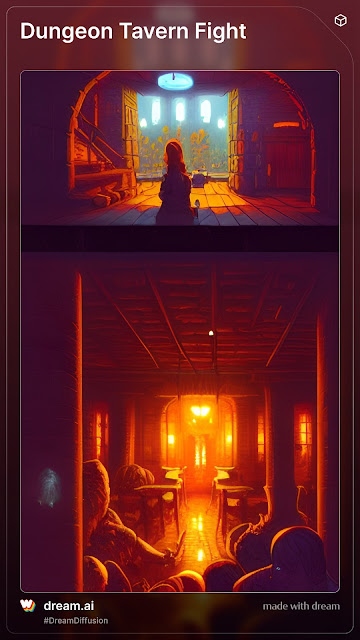Previously: 17 RPG Lessons from the Raiders of the Lost Ark Bar Fight (Part 1)
You’re always hitting SOMETHING
Glasses and bottles shatter as a gunfight rages across the tavern.
Games featuring combat can devolve into a familiar pattern. “Lothgar attacks with his sword… 7… miss. The orc swings with his axe… 4… that’s another miss.” Described this way, combat can feel weightless, boring, static, and low-stakes.
But attacks that miss are rarely just sweeping through the air. Every miss can tell us something about the combat. The resiliency of armor. Quick reflexes. The difficulty created by the terrain or dungeon dressing.
Every miss is a chance to loop back to previous action, or foreshadow what may happen next. Is a miss making noise? Knocking things over? Creating rough terrain? Separating the combatants? Destroying cover?
Of course, a miss is already a bad result for a PC, so we should avoid creating effects that feel like piling on. Changes triggered by misses should usually affect all participants equally, or be random in their ongoing effect.
Reward PCs for engaging with the environment
Jones’ player asks the GM, “can I hit the guy in the center of the room?” The GM says “he has cover behind a sturdy table, it will be hard.” So the player says, “how about hitting the fireplace?”
Some GMs will have a knee-jerk reaction to players trying to “hack” the scenario, but this is exactly the kind of thinking we want to encourage. A GM should absolutely offer more favorable odds or an improved opportunity for success when a player engages with the fiction in a logical way.
Break up static situations
The gunfight is interrupted when one of Toht’s henchman flanks Jones and grapples him.
Fights that don’t end quickly can settle into a static equilibrium. Perhaps PCs and antagonists are just slugging it out, whittling away at each others’ hit points; or both sides have turtled up.
When this happens, introduce disruptive elements, like an enemy flanking a character making ranged attacks. For most TTRPGs, it’s probably more important that this is dramatically interesting than tactically optimal.
Connect one event to the next, even if the rolls were unrelated
After Jones loses a contested grapple roll, Marion succeeds on a stealth check.
A clever GM can frame Marion’s success on her attack as stemming directly from the distraction of Jones’ player’s failure on the previous roll.
Of course, we know that these were independent rolls. But part of GMing is finding meaning and patterns in randomized action. Emphasizing that Marion is taking advantage of an opportunity makes her player feel more capable; and perhaps Jones’ player also feels better about their failure, as it “set up” Marion’s success.
Allow the antagonists to make suboptimal tactical decisions
Players will usually fight in tactically optimal or near-optimal ways. Unless the game in question has a specific focus on tactics, it’s fine to have most antagonists act sub-optimally, as long as it creates a more interesting situation, or “tells the story” of what that antagonist is all about. It shouldn’t be done because the GM is giving the player a break.
Of course, at least some of the time, an enemy should fight just as tactically as the PCs. It will be that much more of a challenge contrasted against the typical encounter.
Morale checks may play out in unexpected ways
Toht tells his henchman to “shoot them… shoot them both.”
There are many ways to imagine how we get to this particular juncture in a fight. Perhaps some previous action in the fight weakened the enemies’ cohesion, even though the fiction points to them holding the upper hand. Dissension and betrayal are powerful tools to spice up an encounter.
As in the previous entry in this list, the important thing to remember is that this follows from what we know about NPC drives, factions, and relationships. As long as the action follows from the established facts of the scenario plus the results of the dice, it can enhance the situation.
Remember that antagonists fail too
Toht reaches for the medallion, not realizing it is dangerously hot to the touch.
It can be difficult to separate GM knowledge from NPC knowledge – but it is useful and rewarding. An NPC who acts with less than the GM’s full knowledge – but in a way that is reasonable given what they do know, and what they want – creates a believable, responsive world.
If the villain escapes, it’s before combat is over
As victory (quite literally) slips from Toht’s fingers, he flees the tavern.
GMs often try to protect antagonist NPCs, with the idea of creating recurring villains, but the rules in many TTRPGs make this unlikely. It works much better if Toht was an unimportant NPC (possibly even unnamed – after all, no one ever speaks his name in the movie) who only becomes important after the fact, based on the events of the fight. That’s classic play-to-find-out action.
Note how Toht gets away while the medallion is still at risk, the fire is still burning, and a henchman is still fighting. A villain who does flee should always try to do so a round or two before combat ends.
As combat ends, pause to consider the complications and developments
Marion joins forces with Jones in the wake of the tavern’s destruction.
The final part of this scene reminds me of the Urban Shadows game I play in. In Urban Shadows, Marion would have a new debt on Jones, and it would inform the subsequent action and give them a reason to “party up.”
In D&D, this would be a great way to add a new PC to an adventuring party. Marion would make an excellent NPC-turned-PC.
The GM in this scenario would also make a note that Toht survived, and that the symbol was burned into this hand, ensuring that the encounter would have far-flung effects later in the campaign…




No comments:
Post a Comment